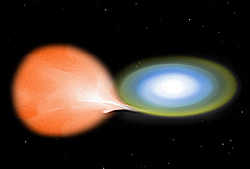
A nova is a transient astronomical event that causes the sudden appearance of a bright, apparently "new" star, that slowly fades over several weeks or many months. Causes of the dramatic appearance of a nova vary, depending on the circumstances of the two progenitor stars. All observed novae involve a white dwarf in a close binary system. The main sub-classes of novae are classical novae, recurrent novae (RNe), and dwarf novae. They are all considered to be cataclysmic variable stars.

Symphyotrichum novae-angliae, the New England aster, hairy Michaelmas-daisy, or Michaelmas daisy, is a species of flowering plant in the family Asteraceae. It is a perennial, herbaceous plant native to eastern North America, and has been introduced to Europe. The seeds and nectar of this fall-flowering species are important to a wide variety of animals. Numerous cultivars have been developed and the species is a popular garden plant, especially in Europe.

Novae was initially one of the few great Roman legionary fortresses along the empire's border, forming part of the defences along the Danube in northern Bulgaria. The settlement later expanded into a town in the Roman province of Moesia Inferior, later Moesia Secunda.
A nova remnant is made up of the material either left behind by a sudden explosive fusion eruption by classical novae, or from multiple ejections by recurrent novae. Over their short lifetimes, nova shells show expansion velocities of around 1000 km/s, whose faint nebulosities are usually illuminated by their progenitor stars via light echos as observed with the spherical shell of Nova Persei 1901 or the energies remaining in the expanding bubbles like T Pyxidis.

A U Geminorum-type variable star, or dwarf nova is one of several types of cataclysmic variable star, consisting of a close binary star system in which one of the components is a white dwarf that accretes matter from its companion. Dwarf novae are dimmer and repeat more frequently than "classical" novae.
A quark-nova is the hypothetical violent explosion resulting from the conversion of a neutron star to a quark star. Analogous to a supernova heralding the birth of a neutron star, a quark nova signals the creation of a quark star. The term quark-novae was coined in 2002 by Dr. Rachid Ouyed and Drs. J. Dey and M. Dey.

The Shrine of Venus Cloacina — the "Shrine of Venus of the Sewer" — was a small sanctuary on the Roman Forum, honoring the divinity of the Cloaca Maxima, the spirit of the "Great Drain" or Sewer of Rome. Cloacina, the Etruscan goddess associated with the entrance to the sewer system, was later identified with the Roman goddess Venus for unknown reasons, according to Pliny the Elder.

_wE, Invaders is the second release, and first EP by Canadian avant-garde extreme metal band uneXpect.
Prodromus Florae Novae Hollandiae et Insulae Van Diemen is a flora of Australia written by botanist Robert Brown and published in 1810. Often referred to as Prodromus Flora Novae Hollandiae, or by its standard botanical abbreviation Prodr. Fl. Nov. Holland., it was the first attempt at a survey of the Australian flora. It described over 2040 species, over half of which were published for the first time.
Supplementum primum Prodromi florae Novae Hollandiae is an 1830 supplement to Robert Brown's Prodromus florae Novae Hollandiae et Insulae Van Diemen. It may be referred to by its standard botanical abbreviation Suppl. Prodr. Fl. Nov. Holl.

A luminous red nova is a stellar explosion thought to be caused by the merging of two stars. They are characterised by a distinct red colour, and a light curve that fades slowly with resurgent brightness in the infrared. Luminous red novae are not related to standard novae, which are explosions that occur on the surface of white dwarf stars.
Symbiotic novae are slow irregular eruptive variable stars with very slow nova-like outbursts with an amplitude of between 9 and 11 magnitudes. The symbiotic nova remains at maximum for one or a few decades, and then declines towards its original luminosity. Variables of this type are double star systems with one red giant, which probably is a Mira variable, and one white dwarf, with markedly contrasting spectra and whose proximity and mass characteristics indicate it as a symbiotic star. The red giant fills its Roche lobe so that matter is transferred to the white dwarf and accumulates until a nova-like outburst occurs, caused by ignition of thermonuclear fusion. The temperature at maximum is estimated to rise up to 200,000 K, similar to the energy source of novae, but dissimilar to the dwarf novae. The slow luminosity increase would then be simply due to time needed for growth of the ionization front in the outburst.
Banksia novae-zelandiae is an extinct species of Banksia, known only from fossil leaves found in the South Island of New Zealand.
Persoonia spathulata is a shrub native to the south coast of Western Australia, to the north and east of Esperance.
Persoonia scabra is a shrub native to the south coastal region of Western Australia, to the northwest and east of Esperance.

Hakea incrassata, commonly known as marble hakea, is a shrub in the family Proteacea and is endemic to Western Australia.
AR Andromedae is a dwarf nova of the SS Cygni type in the constellation Andromeda. Its typical apparent visual magnitude is 17.6, but increases up to 11.0 magnitude during outbursts. The outbursts occur approximately every 23 days.
LL Andromedae is a dwarf nova in the constellation Andromeda, discovered during an outburst in 1979. Its typical apparent visual magnitude is 19.4, but undergoes outbursts events when can reach a peak magnitude of 14.3. Since this magnitude is reached during the most powerful outbursts, while less bright outbursts can occur, it is classified as a SU Ursae Majoris variable.
OS Andromedae, known also as Nova Andromedae 1986, is a classical nova that appeared in the constellation Andromeda during 1986. It reached a peak apparent visual magnitude of 6.3 and had an intrinsic decay time of 25 days. At the estimated distance of 4.2 kiloparsec, its absolute magnitude at the peak was -7.56.







